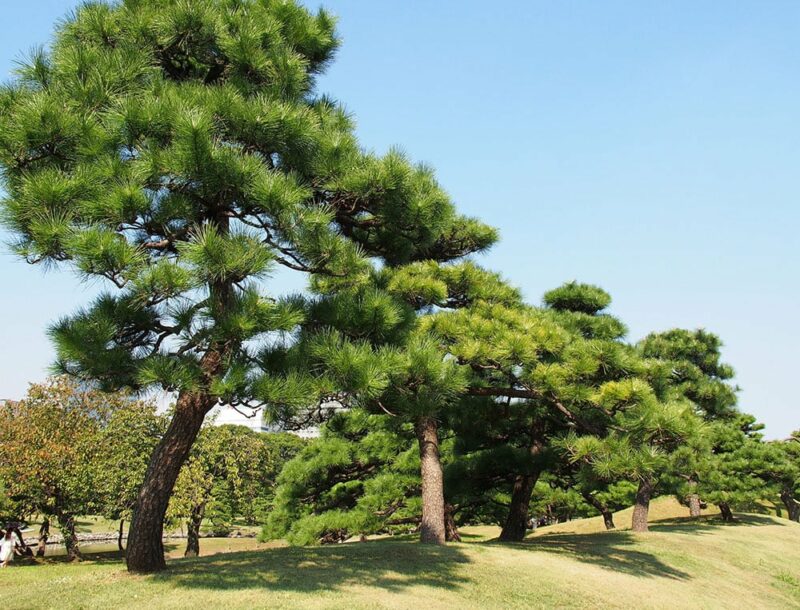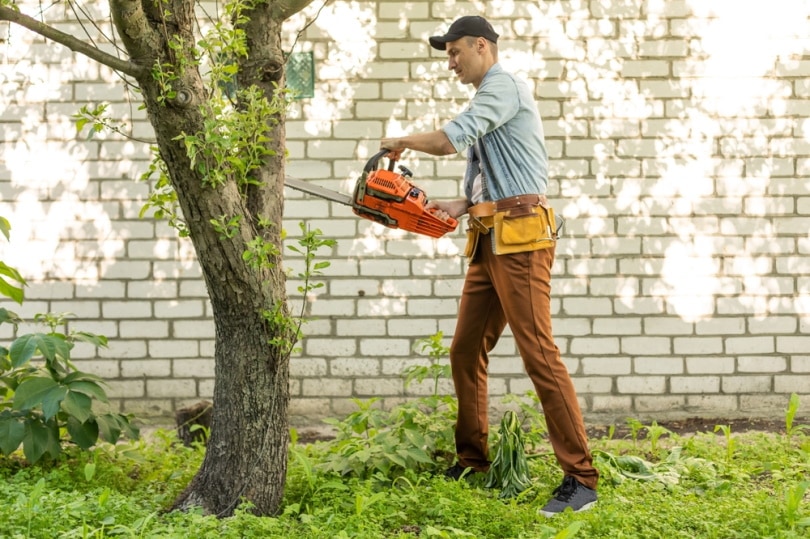Is My Pine Tree Dying? 7 Signs & What To Do
-
- Last updated:

If your pine tree is dying, it will give you a few clear signs, and knowing how to look for them and what to do about them can save your tree. The problem lies if you only notice when it’s too late to do anything about it.
Pine trees add some character to the area, and one dying, especially when it’s already mature, is quite tragic. In this article, we’ve outlined the various signs to look out for and how you can save your sick pine tree.

The 7 Signs That Your Pine Tree Is Dying
If you are keen enough, you can notice when your pine tree is dying. You must take action immediately if you notice any of these signs.
1. Peeling Bark

Peeling bark in small sections is quite normal in pine trees and might not be a sign of a bigger problem. Sometimes the peeling could be caused by changes in seasons or small animals and birds, such as woodpeckers. As long as the damage caused by the peeling is minor, it shouldn’t be a reason for concern. However, if the peeling is happening in huge spots, that’s a clear indication that something is wrong.
2. Discolored Needles
When your tree is sick or dying, the pine needles will slowly turn brown; this may happen in sections. If you notice this sign, you should take a closer look at it before it spreads. Examine a few pine needles from different tree parts and check for brown spots.
3. Early Needle Drop

Many pine trees tend to keep their needles all year long, and only a few species shed their needles at the beginning of fall. If the pine needles drop too early or often, this is a sign that something is wrong with your tree. Certain diseases, such as Dothistroma needle blight and brown spot needle blight, might cause this.
4. Spots on Pinecones
Spots on the pinecones could be a sign of fungal infection or disease. Heterobasidion annosum is an example of a fungal disease that affects pine trees. It can remain dormant for years before resuming its growth when the necessary conditions are met.
5. Excessively Leaking Sap

A little leaking sap from your pine trees is normal. Check to see how much sap is leaking and the consistency; this will help when consulting an expert. Thick ‘waterfalls’ of leaking sap all over your tree are not typical. The leaking sap might turn cloudy depending on the disease, which is a terrible sign.
6. Holes on the Branches
Beetles and other pests find pine trees quite attractive, and they might burrow in the tree for food, shelter, and breeding purposes. In most cases, pests don’t attack a healthy tree, so you should be concerned if you notice holes and sawdust around the tree stem and branches. Burrowing can also leave the trunk and branches of the tree vulnerable to attack from fungi and spores.
7. Crown Die-back

The crown is often the most sensitive to changes in the tree’s health. It’s where new growth typically happens, so if your tree is sick and dying, it will often stagnate in growth. Some noticeable signs include a slow bloom, thin coverage, and dead wood.

How to Deal With a Sick or Dying Pine Tree
Depending on the extent of the disease, you can either save it or cut it down. Unless it’s a severe disease such as Annosus Root Rot, Cotton Root Rot, or Brown Spot Needle Blight, the following tips should help you save your pine tree.
1. Act Fast
The first step should be investigating the problem further and seeing what you can do. This could be broad, and it may take a while. After discovering the problem, you must take care of it as soon as possible.

2. Water It
If you are lucky, these signs could be due to dehydration, especially during the summer and other dry spells. This is especially true if the pine needles are discolored and dropped.
If watering the tree does not make these signs disappear, you can take extra steps to diagnose and treat the disease, like sending samples to the lab or getting a plant pathologist to take a look.
3. Prune the Infected Areas
Fungal diseases can spread quite fast, especially in the right conditions. In this case, it would be helpful to trim the infected area to prevent it from spreading further. Removing dead or dying branches also helps keep diseases and pests away.

4. Treat It With Fungicides & Pesticides
If the fungal infection has not spread too far, you can treat it with a topical application of fungicides or pesticides. Ensure you know what you are doing and the condition you are treating. Otherwise, you might worsen the problem.
5. Add Fertilizer to the Tree
Sometimes, the wilting and dropping pine needles could be due to a lack of nutrients. A natural approach is better than using chemicals, and manure and compost will likely give your pine tree the extra boost it needs.

6. Call an Expert
If all the other solutions above don’t work, consider getting an expert to take a look. They will be able to make the correct diagnosis and advise you on the best way forward. You should do this even when you think you know what is ailing the tree to ensure you are not missing anything.

What Is the Lifespan of a Pine Tree?
Pine trees can live between 50–450 years, depending on the type and the growing conditions. If the soil is good for them and there is minimal pollution, pine trees can live for a long time without getting sick and dying.
The Great Basin Bristlecone Pine tree has the longest life span compared to all other trees. It can live for more than 5,000 years. Its long lifespan can be attributed to the harsh conditions that it lives in. The powerful winds and low temperatures make it develop slowly and resistant to fungi, rot, and pests.

How to Keep Your Pine Tree From Diseases & Death
Poor cultivation of pine trees is mostly to blame for the sickness and death. Beetle infestation and fungal diseases are the main culprits for pine tree death. Prevention is easier and more effective in keeping your pine tree healthy. Here are things you can do to keep your pine tree from dying:
1. Keep Weed Trimmers Away From the Pine Tree
Weed trimmers can make significant cuts on the trunk of pine trees, and the damage can attract pests. Ensure you prune your pine tree during the winter when the bugs are less active. Fungal infections and diseases also spread slower during winter.
2. Transplant Your Pine Tree After Winter
Transplanting trees during the hot season can lead to shock. The best time to transplant them is during winter or the end of fall when the ground is cool. Ensure the planting site meets all the required sun, soil, and climate conditions.
3. Water Your Pine Tree Regularly
Ensure you give your pine tree at least an inch of water weekly for the first 6–8 months after transplanting it. You should also irrigate it often during the hot months or when there is a drought. Doing this prevents your tree from dehydrating and enables it to fight against diseases more effectively.

4. Inspect Your Tree for Lesions Often
Lesions on the bark or branches indicate that your tree is sick. They are caused by a type of fungus that attacks native pine trees. Catching these lesions on time allows you to apply topical treatment, preventing the fungus from spreading and keeping the tree from dying.
If the lesions refuse to heal, consider cutting down the affected tree and burning it to prevent the disease from spreading to the nearby pine trees.
5. Look for Any Mistletoes Growing on the Pine Tree
Dwarf mistletoes infest pines and weaken them by absorbing water and minerals. One of the ways to get rid of them is by pruning the infected area as soon as you notice them. You can also wrap the infected area with strips of black polyethylene to exclude light and keep them from regrowing.

Conclusion
Leaving a sick or dying tree on your property is asking for trouble. Statistically, around 100 people in the US are killed by falling trees. So, if your pine tree is sick beyond saving, consider contacting a professional tree removal service to remove it. You should also burn it to prevent the diseases from spreading to the other trees.
- https://joseknowstrees.com/is-my-pine-tree-sick-or-dying/
- https://www.texastreetrimmers.com/signs-sick-dying-pine-tree/#:~:text=One%20tell%2Dtale%20sign%20of,it%20may%20shed%20its%20bark.
- https://www.gotreequotes.com/how-to-save-a-sick-or-dying-tree/
- https://www.treesatlanta.org/news/the-oldest-tree-in-the-world/
- https://homeguides.sfgate.com/bring-dying-pine-tree-back-life-74622.html
- https://www.reifflawfirm.com/100-people-killed-trees-every-year-united-states/
Featured Image Credit: Takashi Images, Shutterstock
Contents

